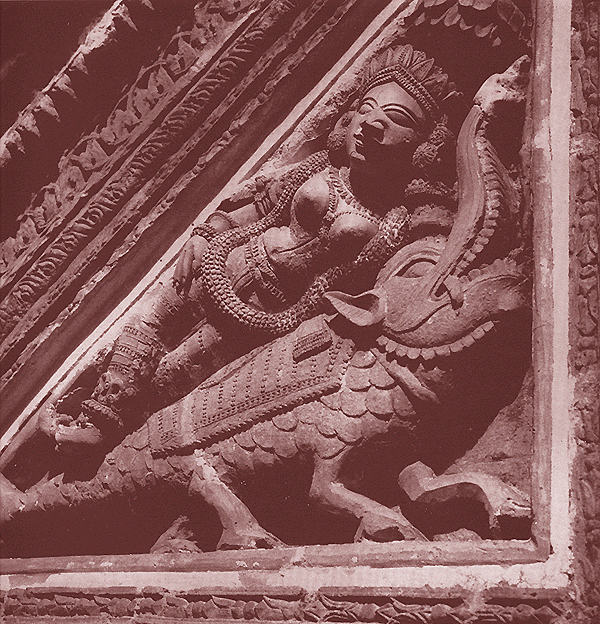Bengali Terracottas - Ganga Ma
BY: SUN STAFF

Ganga Ma on her Makara
Charbangla Temple (North), Baranagar, District Murshidabad, West Bengal
[ Click for larger image ]
Dec 13, CANADA (SUN) — The representation of the goddess Ganga pictured above is found on a triangular terracotta corner-plaque at one of the extremities of the Northern fašade of the temple, just below the carved eaves of the roof. In ancient Indian temples, the river goddesses Ganga Ma and Yamuna devi are found depicted on jambs on either side of the doorway, generally standing in the vidgala attitude, with Ganga on her mount, the snouted crocodile Makara, and Yamuna on her vahana tortoise.
Here the exigencies of space have made the artist represent the demigoddess to recline on the back of her mount, a posture quite unconventional. The profuse decorations on her person, the turreted ardhamukuta, the flowing garland, and other items of jewellery - all elaborately designed and rhythmically disposed - emphasize the smooth beauty of the exquisitely modeled figure. Dignified and restrained, this beautiful presentation of the river goddess is a masterpiece of Bengali terracotta art and does much credit to the unknown sculptor who wrought it.
In the previous segment of Bengali Terracottas we looked at terracotta relics from the Bishnupur area, and summarized the second phase of the artistic period dominated by terracottas in West Bengal. In this phase, large terracotta works were created like those in the form of plaques and temple work from Mahasthan, Paharput and Gokul.
As described in "Indian Terracotta Art", in the third stage of this art movement, the profuse architectural applications of terracottas are exemplified by the works found at numerous Bengali temples. These include the famous temple at Badnagar (Murshidabad), the beautiful temple at Mathurapur (Faridpur District), and the 'sloping roof' temple at Handial (Pabna District). "The decoration of the fašades of the temple, with fashioned and carved bricks and terracottas, became a widespread fashion in temple architecture in Bengal during the third phase of this period. This is well-illustrated in the elegant Sridhara Temple (Bankura), the Lakshmi-Janardan Temple at Hambazar (Birbhum), the Basudeva Temple at Bansabati (Hooghly), and the Madanmohan Temple (Bankura), which feature elaborate representations of themes borrowed from the Puranas.
When studying the details of the fašades of these temples, one is struck by the largeness of conception, the dramatic vigour, and by the liveliness of most of the pictures depicted on bricks and plaques. These ornate terracottas were used in place of vivid wall-paintings and frescoes, the dearth of which is compensated for by these 'pictures' on bricks and plaques.
We can only make a passing reference to the remarkable finds recently discovered by the Calcutta University Archeological Mission from Chandraketugarh, from Beda-champa, (an ancient village in 24 Parganas) and from Hariharpur (nine miles from Calcutta). The former site has yielded many finds, which include early terracottas of Mayuryan, and perhaps, Pre-Mayuryan affinities.
Historians have emphasized the role of terracottas in the evolution of stone sculpture, as described by Bachhofer: "Long before the Mayurya dynasty, there had already existed in India an art of wood-carving or clay-sculpture which definitely shaped and modeled the well-known figures of the Yakshis and the Yakshinis. The fact that a century later, the artists of Bharhut operated with firmly outlined images of gods points in this direction."
As has been pointed out by Sri Paresh Chandra Gupta of the Ashutosh Museum, "Actually, the richly modeled and lively female figures of Didarganj, the elephant figure of Dhauli, the Asokan pillar capitals as well as the so-called Yakhis of Parkham and Patna are pre-supposed (and anticipated) by a lot of ancient terracotta and clay figures recovered from the various ancient Bengali sites already referred to. Several Yakshinis discovered at Tamluk are of a moulded type, and their features, particularly the flattened model, possibly take them anterior to the Sunga Period.
Some of the jewelries and costumes found on the terracottas and clay female figurines of Tamluk are exactly similar to those of the Bharhut representations of Yakshis and Yakshinis. The same elaborate coiffures, the circular and triangular earrings, the channaviras or double garlands, the precious looking girdles made of beads of medallions, as well as the muslin or silken petticoats of transparent quality, -- we find these again and again on both the examples of Tamralipta and the Bharhut railings."
In our next segment, we will begin to explore the wealth of highly intricate panels detailing Lord Krsna's Vrindavan pastimes. These extremely fine terracotta panels are some of the most beautiful renderings of the darling of Braja to be found anywhere in West Bengal.
